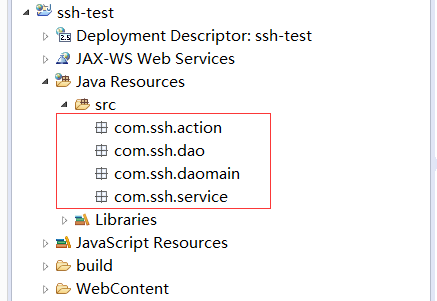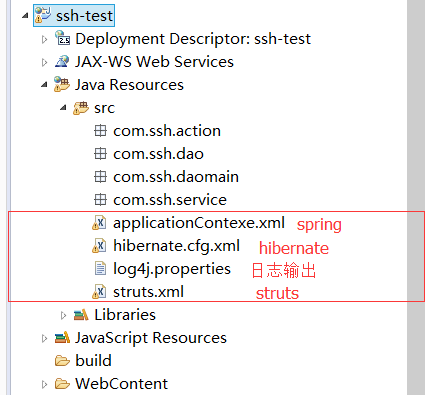SSH
ssh整合,开工
1、首先创建web项目,之后在web文件夹下创建我们所需要的包:web层、service层、dao层,JavaBean工具类也单独创建一个包吧,就这样:

2、接下来在src的目录下创建struts2框架的配置文件(struts.xml)、spring框架的配置文件(applicationContext.xml)和hibernate框架的配置文件(hibernate.cfg.xml),另外再加上日志输出的文件吧(log4j.properties):

3、web.xml配置文件:(固定的,ssh框架万年不变)
<?xml version="1.0" encoding="UTF-8"?> <web-app xmlns:xsi="http://www.w3.org/2001/XMLSchema-instance" xmlns="http://java.sun.com/xml/ns/javaee" xsi:schemaLocation="http://java.sun.com/xml/ns/javaee http://java.sun.com/xml/ns/javaee/web-app_2_5.xsd" id="WebApp_ID" version="2.5"> <display-name>ssh-test</display-name> <!-- 配置Spring框架整合WEB的监听器 --> <listener> <listener-class>org.springframework.web.context.ContextLoaderListener</listener-class> </listener> <context-param> <param-name>contextConfigLocation</param-name> <param-value>classpath:applicationContext.xml</param-value> </context-param> <!-- 配置Struts2框架的核心的过滤器 --> <filter> <filter-name>struts2</filter-name> <filter-class>org.apache.struts2.dispatcher.ng.filter.StrutsPrepareAndExecuteFilter</filter-class> </filter> <filter-mapping> <filter-name>struts2</filter-name> <url-pattern>/*</url-pattern> </filter-mapping> <welcome-file-list> <welcome-file>index.html</welcome-file> <welcome-file>index.htm</welcome-file> <welcome-file>index.jsp</welcome-file> <welcome-file>default.html</welcome-file> <welcome-file>default.htm</welcome-file> <welcome-file>default.jsp</welcome-file> </welcome-file-list> </web-app>
applicationContext.xml配置文件:(因为没有添加项目,所以只有纯净的约束)
<?xml version="1.0" encoding="UTF-8"?> <beans xmlns="http://www.springframework.org/schema/beans" xmlns:xsi="http://www.w3.org/2001/XMLSchema-instance" xmlns:context="http://www.springframework.org/schema/context" xmlns:aop="http://www.springframework.org/schema/aop" xmlns:tx="http://www.springframework.org/schema/tx" xsi:schemaLocation="http://www.springframework.org/schema/beans http://www.springframework.org/schema/beans/spring-beans.xsd http://www.springframework.org/schema/context http://www.springframework.org/schema/context/spring-context.xsd http://www.springframework.org/schema/aop http://www.springframework.org/schema/aop/spring-aop.xsd http://www.springframework.org/schema/tx http://www.springframework.org/schema/tx/spring-tx.xsd"> </beans>
hibernate.cfg.xml的配置文件:(负责数据库连接和JavaBean的映射等)
<?xml version="1.0" encoding="UTF-8"?> <!DOCTYPE hibernate-configuration PUBLIC "-//Hibernate/Hibernate Configuration DTD 3.0//EN" "http://www.hibernate.org/dtd/hibernate-configuration-3.0.dtd"> <hibernate-configuration> <session-factory> <!-- 必须配置 --> <property name="hibernate.connection.driver_class">com.mysql.jdbc.Driver</property> <property name="hibernate.connection.url">jdbc:mysql:///ssh-test</property> <property name="hibernate.connection.username">root</property> <property name="hibernate.connection.password">123</property> <property name="hibernate.dialect">org.hibernate.dialect.MySQLDialect</property> <!-- 可选配置 --> <property name="hibernate.show_sql">true</property> <property name="hibernate.format_sql">true</property> <property name="hibernate.hbm2ddl.auto">update</property> <!-- 配置C3P0的连接池 --> <property name="connection.provider_class">org.hibernate.connection.C3P0ConnectionProvider</property> <!-- 不能配置绑定当前的线程的操作 --> <!-- 映射配置文件 --> <mapping resource="这里在后面填写"/> </session-factory> </hibernate-configuration>
log4j.properties输出日志配置(不解释):
### direct log messages to stdout ###
log4j.appender.stdout=org.apache.log4j.ConsoleAppender
log4j.appender.stdout.Target=System.err
log4j.appender.stdout.layout=org.apache.log4j.PatternLayout
log4j.appender.stdout.layout.ConversionPattern=%d{ABSOLUTE} %5p %c{1}:%L - %m%n
### direct messages to file mylog.log ###
log4j.appender.file=org.apache.log4j.FileAppender
log4j.appender.file.File=c\:mylog.log
log4j.appender.file.layout=org.apache.log4j.PatternLayout
log4j.appender.file.layout.ConversionPattern=%d{ABSOLUTE} %5p %c{1}:%L - %m%n
### set log levels - for more verbose logging change 'info' to 'debug' ###
log4j.rootLogger=info, stdout
struts.xml的配置文档(没加项目,只有约束):
<?xml version="1.0" encoding="UTF-8" ?> <!DOCTYPE struts PUBLIC "-//Apache Software Foundation//DTD Struts Configuration 2.3//EN" "http://struts.apache.org/dtds/struts-2.3.dtd"> <struts> </struts>
好了,按照以上的配置,ssh框加就可以完全运行了,如果有出现错误的地方,还请指正。(目前本人没发现,/斜眼笑)
----------------------------------------下面继续做些增删改查,前端代码略过----------------------------------------------
增加客户:(详细的前台代码已经省略)
jsp页面:

javabean:
package com.ssh-test.domain; public class Customer { private Long cust_id; private String cust_name; private Long cust_user_id; private Long cust_create_id; private String cust_source; private String cust_industry; private String cust_level; private String cust_linkman; private String cust_phone; private String cust_mobile; public Long getCust_id() { return cust_id; } public void setCust_id(Long cust_id) { this.cust_id = cust_id; } public String getCust_name() { return cust_name; } public void setCust_name(String cust_name) { this.cust_name = cust_name; } public Long getCust_user_id() { return cust_user_id; } public void setCust_user_id(Long cust_user_id) { this.cust_user_id = cust_user_id; } public Long getCust_create_id() { return cust_create_id; } public void setCust_create_id(Long cust_create_id) { this.cust_create_id = cust_create_id; } public String getCust_source() { return cust_source; } public void setCust_source(String cust_source) { this.cust_source = cust_source; } public String getCust_industry() { return cust_industry; } public void setCust_industry(String cust_industry) { this.cust_industry = cust_industry; } public String getCust_level() { return cust_level; } public void setCust_level(String cust_level) { this.cust_level = cust_level; } public String getCust_linkman() { return cust_linkman; } public void setCust_linkman(String cust_linkman) { this.cust_linkman = cust_linkman; } public String getCust_phone() { return cust_phone; } public void setCust_phone(String cust_phone) { this.cust_phone = cust_phone; } public String getCust_mobile() { return cust_mobile; } public void setCust_mobile(String cust_mobile) { this.cust_mobile = cust_mobile; } @Override public String toString() { return "Customer [cust_id=" + cust_id + ", cust_name=" + cust_name + ", cust_user_id=" + cust_user_id + ", cust_create_id=" + cust_create_id + ", cust_source=" + cust_source + ", cust_industry=" + cust_industry + ", cust_level=" + cust_level + ", cust_linkman=" + cust_linkman + ", cust_phone=" + cust_phone + ", cust_mobile=" + cust_mobile + "]"; } }
javabean的映射文件:(javabean.hbm.xml)
<?xml version="1.0" encoding="UTF-8"?> <!DOCTYPE hibernate-mapping PUBLIC "-//Hibernate/Hibernate Mapping DTD 3.0//EN" "http://www.hibernate.org/dtd/hibernate-mapping-3.0.dtd"> <hibernate-mapping> <class name="com.ssh-test.domain.Customer" table="cst_customer"> <id name="cust_id" column="cust_id"> <generator class="native"/> </id> <property name="cust_name" column="cust_name"/> <property name="cust_user_id" column="cust_user_id"/> <property name="cust_create_id" column="cust_create_id"/> <property name="cust_source" column="cust_source"/> <property name="cust_industry" column="cust_industry"/> <property name="cust_level" column="cust_level"/> <property name="cust_linkman" column="cust_linkman"/> <property name="cust_phone" column="cust_phone"/> <property name="cust_mobile" column="cust_mobile"/> </class> </hibernate-mapping>
struts.xml配置:
<?xml version="1.0" encoding="UTF-8" ?> <!DOCTYPE struts PUBLIC "-//Apache Software Foundation//DTD Struts Configuration 2.3//EN" "http://struts.apache.org/dtds/struts-2.3.dtd"> <struts> <!-- 先配置包的结构 --> <!-- namespace是jsp页面提交路径的来时,加上下面的action中neme属性,正好是全路径 --> <package name="crm" extends="struts-default" namespace="/"> <!-- 配置客户的Action --> <!-- class是action的全路径 如果Action由Spring框架来管理的话,class标签只需要填写ID值就ok,剩下的系统会自动装配的 --> <action name="customer_*" class="com.itheima.web.action.CustomerAction" method="{1}"> </action> </package> </struts>
applicationContext.xml(spring配置)
<?xml version="1.0" encoding="UTF-8"?> <beans xmlns="http://www.springframework.org/schema/beans" xmlns:xsi="http://www.w3.org/2001/XMLSchema-instance" xmlns:context="http://www.springframework.org/schema/context" xmlns:aop="http://www.springframework.org/schema/aop" xmlns:tx="http://www.springframework.org/schema/tx" xsi:schemaLocation="http://www.springframework.org/schema/beans http://www.springframework.org/schema/beans/spring-beans.xsd http://www.springframework.org/schema/context http://www.springframework.org/schema/context/spring-context.xsd http://www.springframework.org/schema/aop http://www.springframework.org/schema/aop/spring-aop.xsd http://www.springframework.org/schema/tx http://www.springframework.org/schema/tx/spring-tx.xsd"> <!-- 配置客户的模块 --> <bean id="customerService" class="com.itheima.service.CustomerServiceImpl"> </bean> </beans>
CustomerAction.java(也就是struts框架接收前台代码)
/** * 客户的控制层 * @author Administrator * */ public class CustomerAction extends ActionSupport implements ModelDriven<Customer>{ private static final long serialVersionUID = 6168304372879392674L; //这就是模型驱动,不要忘记自己手动去new private Customer customer = new Customer(); public Customer getModel() { return customer; } /** * 保存客户的方法 * @return */ public String add(){ //在这里调试输出一下,看看struts是否正常 System.out.println(customer); //拿到web工厂 WebApplicationContext context = WebApplicationContextUtils.getWebApplicationContext(ServletActionContext.getServletContext()); CustomerService cs = (CustomerService) context.getBean("customerService"); // 调用方法 cs.save(customer); return NONE; } }
临时有事,未完待续




